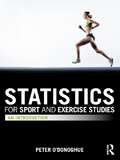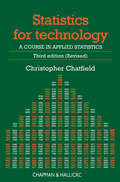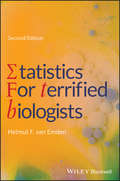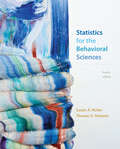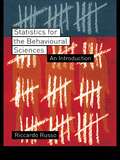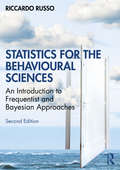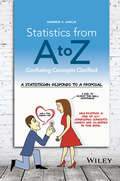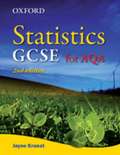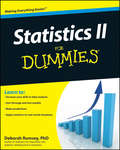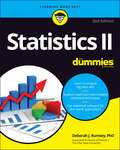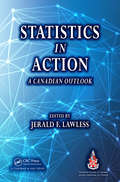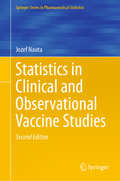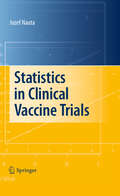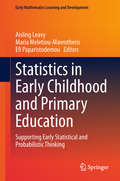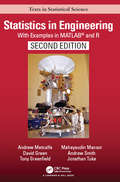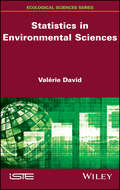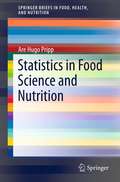- Table View
- List View
Statistics for Sport and Exercise Studies: An Introduction
by Peter O'DonoghueStatistics for Sport and Exercise Studies guides the student through the full research process, from selecting the most appropriate statistical procedure, to analysing data, to the presentation of results, illustrating every key step in the process with clear examples, case-studies and data taken from real sport and exercise settings. Every chapter includes a range of features designed to help the student grasp the underlying concepts and relate each statistical procedure to their own research project, including definitions of key terms, practical exercises, worked examples and clear summaries. The book also offers an in-depth and practical guide to using SPSS in sport and exercise research, the most commonly used data analysis software in sport and exercise departments. In addition, a companion website includes more than 100 downloadable data sets and work sheets for use in or out of the classroom, full solutions to exercises contained in the book, plus over 1,300 PowerPoint slides for use by tutors and lecturers. Statistics for Sport and Exercise Studies is a complete, user-friendly introduction to the use of statistical tests, techniques and procedures in sport, exercise and related subjects. Visit the companion website at: www.routledge.com/cw/odonoghue
Statistics for Technology: A Course in Applied Statistics, Third Edition
by Chris ChatfieldOne of the most popular introductory texts in its field, Statistics for Technology: A Course in Applied Studies presents the range of statistical methods commonly used in science, social science, and engineering.The mathematics are simple and straightforward; statistical concepts are explained carefully; and real-life (rather than contrived) examples are used throughout the chapters.Divided into three parts, the Introduction describes some simple methods of summarizing data. Theory examines the basic concepts and theory of statistics. Applications covers the planning and procedures of experiments, quality control, and life testing.Revised throughout, this Third Edition places a higher priority on the role of computers in analysis, and many new references have been incorporated. A new appendix describes general methods of tackling statistical problems, including guidance on literature searching and report writing.
Statistics for Technology: A Course in Applied Statistics, Third Edition
by Chris ChatfieldOne of the most popular introductory texts in its field, Statistics for Technology: A Course in Applied Studies presents the range of statistical methods commonly used in science, social science, and engineering.The mathematics are simple and straightforward; statistical concepts are explained carefully; and real-life (rather than contrived) examples are used throughout the chapters.Divided into three parts, the Introduction describes some simple methods of summarizing data. Theory examines the basic concepts and theory of statistics. Applications covers the planning and procedures of experiments, quality control, and life testing.Revised throughout, this Third Edition places a higher priority on the role of computers in analysis, and many new references have been incorporated. A new appendix describes general methods of tackling statistical problems, including guidance on literature searching and report writing.
Statistics for Terrified Biologists
by Helmut F. van EmdenMakes mathematical and statistical analysis understandable to even the least math-minded biology student This unique textbook aims to demystify statistical formulae for the average biology student. Written in a lively and engaging style, Statistics for Terrified Biologists, 2nd Edition draws on the author’s 30 years of lecturing experience to teach statistical methods to even the most guarded of biology students. It presents basic methods using straightforward, jargon-free language. Students are taught to use simple formulae and how to interpret what is being measured with each test and statistic, while at the same time learning to recognize overall patterns and guiding principles. Complemented by simple examples and useful case studies, this is an ideal statistics resource tool for undergraduate biology and environmental science students who lack confidence in their mathematical abilities. Statistics for Terrified Biologists presents readers with the basic foundations of parametric statistics, the t-test, analysis of variance, linear regression and chi-square, and guides them to important extensions of these techniques. It introduces them to non-parametric tests, and includes a checklist of non-parametric methods linked to their parametric counterparts. The book also provides many end-of-chapter summaries and additional exercises to help readers understand and practice what they’ve learned. Presented in a clear and easy-to-understand style Makes statistics tangible and enjoyable for even the most hesitant student Features multiple formulas to facilitate comprehension Written by of the foremost entomologists of his generation This second edition of Statistics for Terrified Biologists is an invaluable guide that will be of great benefit to pre-health and biology undergraduate students.
Statistics for the Behavioral Sciences
by Susan Nolan Thomas HeinzenThis core textbook offers an introduction to the basics of statistics that is uniquely suited to behavioural science students. The book offers coverage anchored to real-world stories, a highly visual approach, helpful mathematical support, and useful step-by-step examples. The new edition also focuses on emerging trends that are redefining contemporary behavioural statistics.This textbook helps undergraduate behavioural science students taking modules in Research Methods and Statistics get to grips with a subject they often find challenging in an enjoyable and engaging way.The book can also be purchased with the breakthrough online resource, LaunchPad, which offers innovative media content, curated and organised for easy assignability. LaunchPad's intuitive interface presents quizzing, flashcards, animations and much more to make learning actively engaging.
Statistics for the Behavioural Sciences: An Introduction
by Riccardo RussoDo you find statistics overwhelming and confusing? Have you ever wished for someone to explain the basics in a clear and easy-to-follow style? This accessible textbook gives a step-by-step introduction to all the topics covered in introductory statistics courses for the behavioural sciences, with plenty of examples discussed in depth, based on real psychology experiments utilising the statistical techniques described. Advanced sections are also provided, for those who want to learn a particular topic in more depth.Statistics for the Behavioural Sciences: An Introduction begins with an introduction to the basic concepts, before providing a detailed explanation of basic statistical tests and concepts such as descriptive statistics, probability, the binomial distribution, continuous random variables, the normal distribution, the Chi-Square distribution, the analysis of categorical data, t-tests, correlation and regression. This timely and highly readable text will be invaluable to undergraduate students of psychology, and students of research methods courses in related disciplines, as well as anyone with an interest in the basic concepts and tests associated with statistics in the behavioural sciences.
Statistics for the Behavioural Sciences: An Introduction
by Riccardo RussoDo you find statistics overwhelming and confusing? Have you ever wished for someone to explain the basics in a clear and easy-to-follow style? This accessible textbook gives a step-by-step introduction to all the topics covered in introductory statistics courses for the behavioural sciences, with plenty of examples discussed in depth, based on real psychology experiments utilising the statistical techniques described. Advanced sections are also provided, for those who want to learn a particular topic in more depth.Statistics for the Behavioural Sciences: An Introduction begins with an introduction to the basic concepts, before providing a detailed explanation of basic statistical tests and concepts such as descriptive statistics, probability, the binomial distribution, continuous random variables, the normal distribution, the Chi-Square distribution, the analysis of categorical data, t-tests, correlation and regression. This timely and highly readable text will be invaluable to undergraduate students of psychology, and students of research methods courses in related disciplines, as well as anyone with an interest in the basic concepts and tests associated with statistics in the behavioural sciences.
Statistics for the Behavioural Sciences: An Introduction to Frequentist and Bayesian Approaches
by Riccardo RussoThis accessible textbook is for those without a mathematical background (just some notions of basic algebra are sufficient) and provides a comprehensive introduction to all topics covered in introductory behavioural science statistics courses. It includes plenty of real examples to demonstrate approaches in depth based on real psychology experiments utilizing the statistical techniques described. New content in this thoroughly updated second edition includes an introduction to Bayesian statistics which complements the coverage of Classical/Frequentist statistics present in the first edition. It also offers practical details on how to perform analyses using JASP – a globally employed, freely downloadable statistical package. The updated eResources also feature a range of new material including additional exercises so readers can test themselves on what they have learned in the book. This timely and highly readable text will be invaluable to undergraduate students of psychology and research methods courses in related disciplines, as well as anyone with an interest in understanding and applying the basic concepts and inferential techniques associated with statistics in the behavioural sciences.
Statistics for the Behavioural Sciences: An Introduction to Frequentist and Bayesian Approaches
by Riccardo RussoThis accessible textbook is for those without a mathematical background (just some notions of basic algebra are sufficient) and provides a comprehensive introduction to all topics covered in introductory behavioural science statistics courses. It includes plenty of real examples to demonstrate approaches in depth based on real psychology experiments utilizing the statistical techniques described. New content in this thoroughly updated second edition includes an introduction to Bayesian statistics which complements the coverage of Classical/Frequentist statistics present in the first edition. It also offers practical details on how to perform analyses using JASP – a globally employed, freely downloadable statistical package. The updated eResources also feature a range of new material including additional exercises so readers can test themselves on what they have learned in the book. This timely and highly readable text will be invaluable to undergraduate students of psychology and research methods courses in related disciplines, as well as anyone with an interest in understanding and applying the basic concepts and inferential techniques associated with statistics in the behavioural sciences.
Statistics from A to Z: Confusing Concepts Clarified
by Andrew A. JawlikStatistics is confusing, even for smart, technically competent people. And many students and professionals find that existing books and web resources don’t give them an intuitive understanding of confusing statistical concepts. That is why this book is needed. Some of the unique qualities of this book are: • Easy to Understand: Uses unique “graphics that teach” such as concept flow diagrams, compare-and-contrast tables, and even cartoons to enhance “rememberability.” • Easy to Use: Alphabetically arranged, like a mini-encyclopedia, for easy lookup on the job, while studying, or during an open-book exam. • Wider Scope: Covers Statistics I and Statistics II and Six Sigma Black Belt, adding such topics as control charts and statistical process control, process capability analysis, and design of experiments. As a result, this book will be useful for business professionals and industrial engineers in addition to students and professionals in the social and physical sciences. In addition, each of the 60+ concepts is covered in one or more articles. The 75 articles in the book are usually 5–7 pages long, ensuring that things are presented in “bite-sized chunks.” The first page of each article typically lists five “Keys to Understanding” which tell the reader everything they need to know on one page. This book also contains an article on “Which Statistical Tool to Use to Solve Some Common Problems”, additional “Which to Use When” articles on Control Charts, Distributions, and Charts/Graphs/Plots, as well as articles explaining how different concepts work together (e.g., how Alpha, p, Critical Value, and Test Statistic interrelate). ANDREW A. JAWLIK received his B.S. in Mathematics and his M.S. in Mathematics and Computer Science from the University of Michigan. He held jobs with IBM in marketing, sales, finance, and information technology, as well as a position as Process Executive. In these jobs, he learned how to communicate difficult technical concepts in easy - to - understand terms. He completed Lean Six Sigma Black Belt coursework at the IASSC - accredited Pyzdek Institute. In order to understand the confusing statistics involved, he wrote explanations in his own words and graphics. Using this material, he passed the certification exam with a perfect score. Those statistical explanations then became the starting point for this book.
Statistics from A to Z: Confusing Concepts Clarified
by Andrew A. JawlikStatistics is confusing, even for smart, technically competent people. And many students and professionals find that existing books and web resources don’t give them an intuitive understanding of confusing statistical concepts. That is why this book is needed. Some of the unique qualities of this book are: • Easy to Understand: Uses unique “graphics that teach” such as concept flow diagrams, compare-and-contrast tables, and even cartoons to enhance “rememberability.” • Easy to Use: Alphabetically arranged, like a mini-encyclopedia, for easy lookup on the job, while studying, or during an open-book exam. • Wider Scope: Covers Statistics I and Statistics II and Six Sigma Black Belt, adding such topics as control charts and statistical process control, process capability analysis, and design of experiments. As a result, this book will be useful for business professionals and industrial engineers in addition to students and professionals in the social and physical sciences. In addition, each of the 60+ concepts is covered in one or more articles. The 75 articles in the book are usually 5–7 pages long, ensuring that things are presented in “bite-sized chunks.” The first page of each article typically lists five “Keys to Understanding” which tell the reader everything they need to know on one page. This book also contains an article on “Which Statistical Tool to Use to Solve Some Common Problems”, additional “Which to Use When” articles on Control Charts, Distributions, and Charts/Graphs/Plots, as well as articles explaining how different concepts work together (e.g., how Alpha, p, Critical Value, and Test Statistic interrelate). ANDREW A. JAWLIK received his B.S. in Mathematics and his M.S. in Mathematics and Computer Science from the University of Michigan. He held jobs with IBM in marketing, sales, finance, and information technology, as well as a position as Process Executive. In these jobs, he learned how to communicate difficult technical concepts in easy - to - understand terms. He completed Lean Six Sigma Black Belt coursework at the IASSC - accredited Pyzdek Institute. In order to understand the confusing statistics involved, he wrote explanations in his own words and graphics. Using this material, he passed the certification exam with a perfect score. Those statistical explanations then became the starting point for this book.
Statistics GCSE for AQA (PDF)
by Jayne KranatThis new edition of an established popular resource covers the new GCSE Statistics curriculum for first teaching in 2009. It brings the study and interpretation of statistics to life, making it clear and compelling for all your students. It clearly shows the overlap with GCSE Maths, to help teaching to be focused most effectively, and contains clear worked examples, with lots of practice and past exam questions to fully prepare students for success in their exam, whichever tier they are taking.
Statistics II for Dummies
by Deborah J. RumseyThe ideal supplement and study guide for students preparing for advanced statistics Packed with fresh and practical examples appropriate for a range of degree-seeking students, Statistics II For Dummies helps any reader succeed in an upper-level statistics course. It picks up with data analysis where Statistics For Dummies left off, featuring new and updated examples, real-world applications, and test-taking strategies for success. This easy-to-understand guide covers such key topics as sorting and testing models, using regression to make predictions, performing variance analysis (ANOVA), drawing test conclusions with chi-squares, and making comparisons with the Rank Sum Test.
Statistics II for Dummies
by Deborah J. RumseyThe ideal supplement and study guide for students preparing for advanced statistics Packed with fresh and practical examples appropriate for a range of degree-seeking students, Statistics II For Dummies helps any reader succeed in an upper-level statistics course. It picks up with data analysis where Statistics For Dummies left off, featuring new and updated examples, real-world applications, and test-taking strategies for success. This easy-to-understand guide covers such key topics as sorting and testing models, using regression to make predictions, performing variance analysis (ANOVA), drawing test conclusions with chi-squares, and making comparisons with the Rank Sum Test.
Statistics II For Dummies
by Deborah J. RumseyContinue your statistics journey with this all-encompassing reference Completed Statistics through standard deviations, confidence intervals, and hypothesis testing? Then you’re ready for the next step: Statistics II. And there’s no better way to tackle this challenging subject than with Statistics II For Dummies! Get a brief overview of Statistics I in case you need to brush up on earlier topics, and then dive into a full explanation of all Statistic II concepts, including multiple regression, analysis of variance (ANOVA), Chi-square tests, nonparametric procedures, and analyzing large data sets. By the end of the book, you’ll know how to use all the statistics tools together to create a great story about your data. For each Statistics II technique in the book, you get an overview of when and why it’s used, how to know when you need it, step-by-step directions on how to do it, and tips and tricks for working through the solution. You also find: What makes each technique distinct and what the results say How to apply techniques in real life An interpretation of the computer output for data analysis purposes Instructions for using Minitab to work through many of the calculations Practice with a lot of examples With Statistics II For Dummies, you will find even more techniques to analyze a set of data. Get a head start on your Statistics II class, or use this in conjunction with your textbook to help you thrive in statistics!
Statistics II For Dummies
by Deborah J. RumseyContinue your statistics journey with this all-encompassing reference Completed Statistics through standard deviations, confidence intervals, and hypothesis testing? Then you’re ready for the next step: Statistics II. And there’s no better way to tackle this challenging subject than with Statistics II For Dummies! Get a brief overview of Statistics I in case you need to brush up on earlier topics, and then dive into a full explanation of all Statistic II concepts, including multiple regression, analysis of variance (ANOVA), Chi-square tests, nonparametric procedures, and analyzing large data sets. By the end of the book, you’ll know how to use all the statistics tools together to create a great story about your data. For each Statistics II technique in the book, you get an overview of when and why it’s used, how to know when you need it, step-by-step directions on how to do it, and tips and tricks for working through the solution. You also find: What makes each technique distinct and what the results say How to apply techniques in real life An interpretation of the computer output for data analysis purposes Instructions for using Minitab to work through many of the calculations Practice with a lot of examples With Statistics II For Dummies, you will find even more techniques to analyze a set of data. Get a head start on your Statistics II class, or use this in conjunction with your textbook to help you thrive in statistics!
Statistics in Action: A Canadian Outlook
by Jerald F. LawlessCommissioned by the Statistical Society of Canada (SSC), Statistics in Action: A Canadian Outlook helps both general readers and users of statistics better appreciate the scope and importance of statistics. It presents the ways in which statistics is used while highlighting key contributions that Canadian statisticians are making to science, techno
Statistics in Clinical and Observational Vaccine Studies (Springer Series in Pharmaceutical Statistics)
by Jozef NautaThis book offers an overview of the statistical methods used in clinical and observational vaccine studies. Pursuing a practical rather than theoretical approach, it presents a range of real-world examples with SAS codes, making the application of the methods straightforward. This revised edition has been significantly expanded to reflect the current interest in this area. It opens with two introductory chapters on the immunology of vaccines to provide readers with the necessary background knowledge. It then continues with an in-depth exploration of the analysis of immunogenicity data. Discussed are, amongst others, maximum likelihood estimation for censored antibody titers, ANCOVA for antibody values, analysis of data of equivalence, and non-inferiority immunogenicity studies. Other topics covered include fitting protection curves to data from vaccine efficacy studies, and the analysis of vaccine safety data. In addition, the book features four new chapters on vaccine field studies: an introductory one, one on randomized vaccine efficacy studies, one on observational vaccine effectiveness studies, and one on the meta-analysis of vaccine efficacy studies. The book offers useful insights for statisticians and epidemiologists working in the pharmaceutical industry or at vaccines institutes, as well as graduate students interested in pharmaceutical statistics.
Statistics in Clinical Vaccine Trials
by Jozef NautaThis monograph offers well-founded training and expertise on the statistical analysis of data from clinical vaccine trials, i.e., immunogenicity and vaccine field efficacy studies. The book's scope is practical rather than theoretical. It opens with two introductory chapters on the immunology of vaccines to provide readers with the necessary background knowledge. It then continues with an in-depth exploration of the statistical methodology. Many real-life examples and SAS codes are presented, making application of the methods straightforward. Topics discussed include maximum likelihood estimation for censored antibody titers, ANCOVA for antibody values, analysis of equivalence and non-inferiority immunogenicity trial data, analysis of data from vaccine field efficacy trials (including data from studies with recurrent infection data), fitting protection curves to data of challenge or field efficacy studies, and the analysis of vaccine safety data.
Statistics in Early Childhood and Primary Education: Supporting Early Statistical and Probabilistic Thinking (Early Mathematics Learning and Development)
by Aisling Leavy Maria Meletiou-Mavrotheris Efi PaparistodemouThis compilation focuses on the theory and conceptualisation of statistics and probability in the early years and the development of young children’s (ages 3-10) understanding of data and chance. It provides a comprehensive overview of cutting-edge international research on the development of young learners’ reasoning about data and chance in formal, informal, and non-formal educational contexts. The authors share insights into young children’s statistical and probabilistic reasoning and provide early childhood educators and researchers with a wealth of illustrative examples, suggestions, and practical strategies on how to address the challenges arising from the introduction of statistical and probabilistic concepts in pre-school and school curricula. This collection will inform practices in research and teaching by providing a detailed account of current best practices, challenges, and issues, and of future trends and directions in early statistical and probabilistic learning worldwide. Further, it will contribute to future research and theory building by addressing theoretical, epistemological, and methodological considerations regarding the design of probability and statistics learning environments for young children.
Statistics in Engineering: With Examples in MATLAB® and R, Second Edition (Chapman & Hall/CRC Texts in Statistical Science)
by Andrew Metcalfe David Green Tony Greenfield Mayhayaudin Mansor Andrew Smith Jonathan TukeEngineers are expected to design structures and machines that can operate in challenging and volatile environments, while allowing for variation in materials and noise in measurements and signals. Statistics in Engineering, Second Edition: With Examples in MATLAB and R covers the fundamentals of probability and statistics and explains how to use these basic techniques to estimate and model random variation in the context of engineering analysis and design in all types of environments. The first eight chapters cover probability and probability distributions, graphical displays of data and descriptive statistics, combinations of random variables and propagation of error, statistical inference, bivariate distributions and correlation, linear regression on a single predictor variable, and the measurement error model. This leads to chapters including multiple regression; comparisons of several means and split-plot designs together with analysis of variance; probability models; and sampling strategies. Distinctive features include: All examples based on work in industry, consulting to industry, and research for industry Examples and case studies include all engineering disciplines Emphasis on probabilistic modeling including decision trees, Markov chains and processes, and structure functions Intuitive explanations are followed by succinct mathematical justifications Emphasis on random number generation that is used for stochastic simulations of engineering systems, demonstration of key concepts, and implementation of bootstrap methods for inference Use of MATLAB and the open source software R, both of which have an extensive range of statistical functions for standard analyses and also enable programing of specific applications Use of multiple regression for times series models and analysis of factorial and central composite designs Inclusion of topics such as Weibull analysis of failure times and split-plot designs that are commonly used in industry but are not usually included in introductory textbooks Experiments designed to show fundamental concepts that have been tested with large classes working in small groups Website with additional materials that is regularly updated Andrew Metcalfe, David Green, Andrew Smith, and Jonathan Tuke have taught probability and statistics to students of engineering at the University of Adelaide for many years and have substantial industry experience. Their current research includes applications to water resources engineering, mining, and telecommunications. Mahayaudin Mansor worked in banking and insurance before teaching statistics and business mathematics at the Universiti Tun Abdul Razak Malaysia and is currently a researcher specializing in data analytics and quantitative research in the Health Economics and Social Policy Research Group at the Australian Centre for Precision Health, University of South Australia. Tony Greenfield, formerly Head of Process Computing and Statistics at the British Iron and Steel Research Association, is a statistical consultant. He has been awarded the Chambers Medal for outstanding services to the Royal Statistical Society; the George Box Medal by the European Network for Business and Industrial Statistics for Outstanding Contributions to Industrial Statistics; and the William G. Hunter Award by the American Society for Quality.
Statistics in Engineering: With Examples in MATLAB® and R, Second Edition (Chapman & Hall/CRC Texts in Statistical Science)
by Andrew Metcalfe David Green Tony Greenfield Mayhayaudin Mansor Andrew Smith Jonathan TukeEngineers are expected to design structures and machines that can operate in challenging and volatile environments, while allowing for variation in materials and noise in measurements and signals. Statistics in Engineering, Second Edition: With Examples in MATLAB and R covers the fundamentals of probability and statistics and explains how to use these basic techniques to estimate and model random variation in the context of engineering analysis and design in all types of environments. The first eight chapters cover probability and probability distributions, graphical displays of data and descriptive statistics, combinations of random variables and propagation of error, statistical inference, bivariate distributions and correlation, linear regression on a single predictor variable, and the measurement error model. This leads to chapters including multiple regression; comparisons of several means and split-plot designs together with analysis of variance; probability models; and sampling strategies. Distinctive features include: All examples based on work in industry, consulting to industry, and research for industry Examples and case studies include all engineering disciplines Emphasis on probabilistic modeling including decision trees, Markov chains and processes, and structure functions Intuitive explanations are followed by succinct mathematical justifications Emphasis on random number generation that is used for stochastic simulations of engineering systems, demonstration of key concepts, and implementation of bootstrap methods for inference Use of MATLAB and the open source software R, both of which have an extensive range of statistical functions for standard analyses and also enable programing of specific applications Use of multiple regression for times series models and analysis of factorial and central composite designs Inclusion of topics such as Weibull analysis of failure times and split-plot designs that are commonly used in industry but are not usually included in introductory textbooks Experiments designed to show fundamental concepts that have been tested with large classes working in small groups Website with additional materials that is regularly updated Andrew Metcalfe, David Green, Andrew Smith, and Jonathan Tuke have taught probability and statistics to students of engineering at the University of Adelaide for many years and have substantial industry experience. Their current research includes applications to water resources engineering, mining, and telecommunications. Mahayaudin Mansor worked in banking and insurance before teaching statistics and business mathematics at the Universiti Tun Abdul Razak Malaysia and is currently a researcher specializing in data analytics and quantitative research in the Health Economics and Social Policy Research Group at the Australian Centre for Precision Health, University of South Australia. Tony Greenfield, formerly Head of Process Computing and Statistics at the British Iron and Steel Research Association, is a statistical consultant. He has been awarded the Chambers Medal for outstanding services to the Royal Statistical Society; the George Box Medal by the European Network for Business and Industrial Statistics for Outstanding Contributions to Industrial Statistics; and the William G. Hunter Award by the American Society for Quality.
Statistics in Environmental Sciences
by Valerie DavidStatistical tools are indispensable for the environmental sciences. They have become an integral part of the scientific process, from the development of the sampling plan to the obtainment of results. Statistics in Environmental Sciences provides the foundation for the interpretation of quantitative data (basic vocabulary, main laws of probabilities, etc.) and the thinking behind sampling and experimental methodology. It also introduces the principles of statistical tests such as decision theory and examines the key choices in statistical tests, while keeping the established objectives in mind. The book examines the most used statistics in the field of environmental sciences. Detailed descriptions based on concrete examples are given, as well as descriptions obtained through the use of the free software R (whose usage is also presented).
Statistics in Environmental Sciences
by Valerie DavidStatistical tools are indispensable for the environmental sciences. They have become an integral part of the scientific process, from the development of the sampling plan to the obtainment of results. Statistics in Environmental Sciences provides the foundation for the interpretation of quantitative data (basic vocabulary, main laws of probabilities, etc.) and the thinking behind sampling and experimental methodology. It also introduces the principles of statistical tests such as decision theory and examines the key choices in statistical tests, while keeping the established objectives in mind. The book examines the most used statistics in the field of environmental sciences. Detailed descriptions based on concrete examples are given, as well as descriptions obtained through the use of the free software R (whose usage is also presented).
Statistics in Food Science and Nutrition (SpringerBriefs in Food, Health, and Nutrition)
by Are Hugo PrippMany statistical innovations are linked to applications in food science. For example, the student t-test (a statistical method) was developed to monitor the quality of stout at the Guinness Brewery and multivariate statistical methods are applied widely in the spectroscopic analysis of foods. Nevertheless, statistical methods are most often associated with engineering, mathematics, and the medical sciences, and are rarely thought to be driven by food science. Consequently, there is a dearth of statistical methods aimed specifically at food science, forcing researchers to utilize methods intended for other disciplines. The objective of this Brief will be to highlight the most needed and relevant statistical methods in food science and thus eliminate the need to learn about these methods from other fields. All methods and their applications will be illustrated with examples from research literature.
